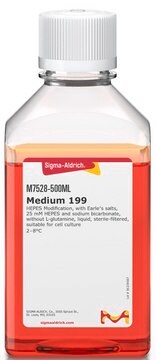M2520
Medium 199
HEPES Modification, with Earle′s salts, L-glutamine and 25 mM HEPES, without sodium bicarbonate, powder, suitable for cell culture
Synonym(s):
M199 Medium, TCM 199
About This Item
Recommended Products
Quality Level
form
powder
technique(s)
cell culture | mammalian: suitable
components
L-glutamine: yes
phenol red: yes
Earle’s salts (5% CO2): yes
NaHCO3: no
sodium pyruvate: no
HEPES: 25 mM
shipped in
ambient
storage temp.
2-8°C
Looking for similar products? Visit Product Comparison Guide
General description
Application
- maintain the cumulus-oocyte complex (COC) before maturation and for culturing of these oocytes for in vitro maturation
- to rinse the aspiration line during the collection of the ovum from German Holstein cows
- to culture cardiac endothelial cells from rats
Quantity
Reconstitution
also commonly purchased with this product
Storage Class
11 - Combustible Solids
wgk_germany
WGK 1
flash_point_f
Not applicable
flash_point_c
Not applicable
Choose from one of the most recent versions:
Already Own This Product?
Find documentation for the products that you have recently purchased in the Document Library.
Customers Also Viewed
Articles
When properly supplemented, Medium 199 (M199) has broad species applicability, particularly for cultivation of non-transformed cells. It is widely used in virology, vaccine production and in vitro cultivation of primary explants of mouse pancreatic epithelial and rat lens tissues.
Protocols
Powdered media and salt mixtures are extremely hygroscopic and should be protected from atmospheric moisture.
Our team of scientists has experience in all areas of research including Life Science, Material Science, Chemical Synthesis, Chromatography, Analytical and many others.
Contact Technical Service





